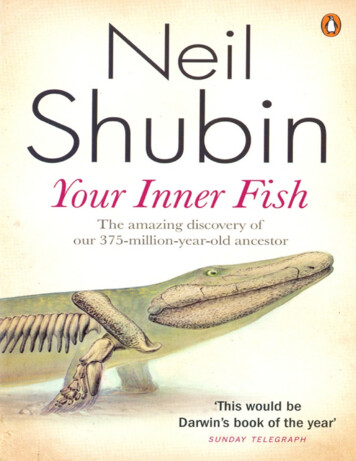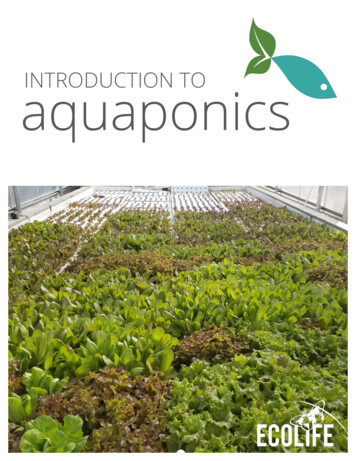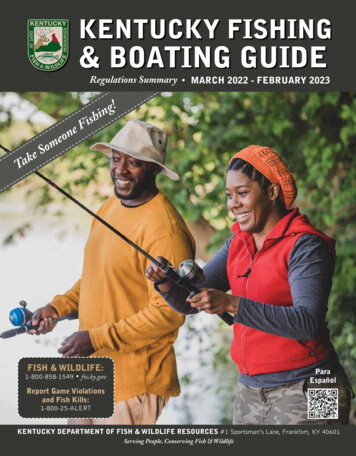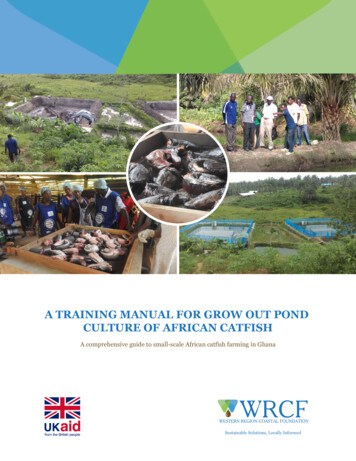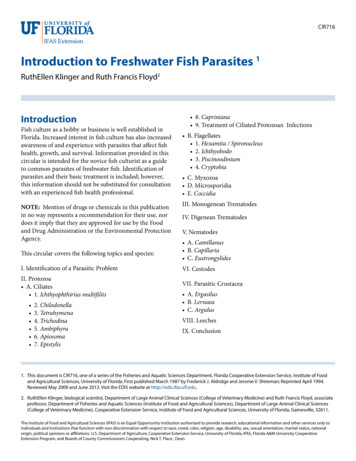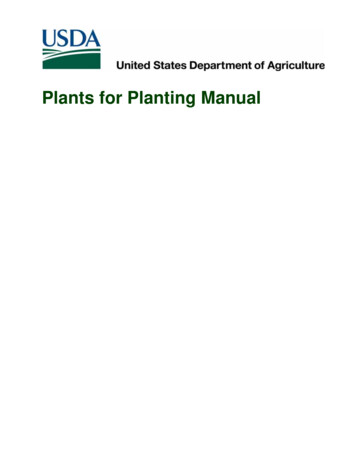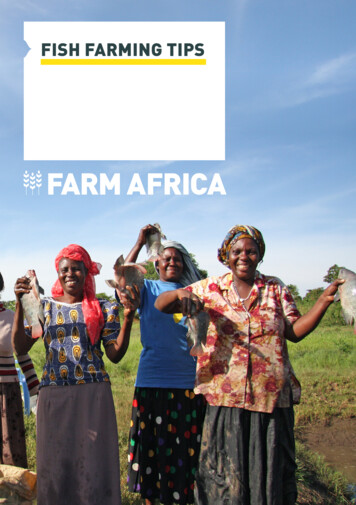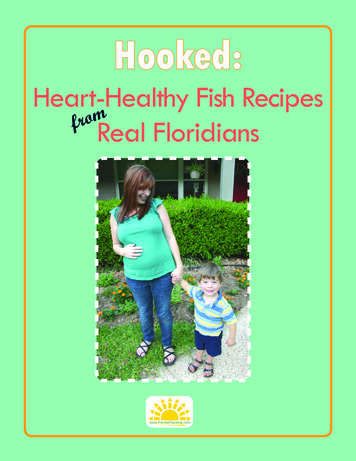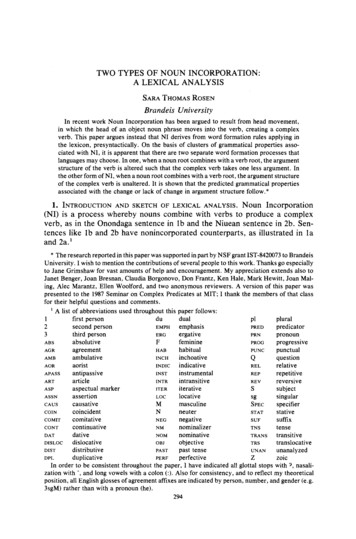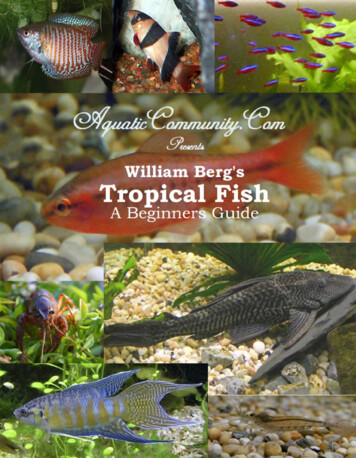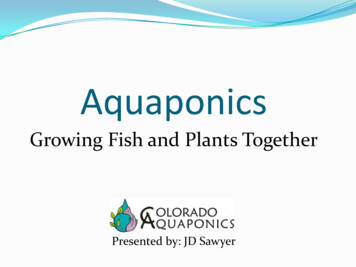
Transcription
AquaponicsGrowing Fish and Plants TogetherPresented by: JD Sawyer
Aquaponics DefinedThe integration of: Aquaculture – Growing fish in are-circulating system Ponos – The Greek word for growingplants with or without media Most people relate growing plants to hydroponics since bothuse nutrient rich water and both use soil-less media.
How Aquaponics Works1.2.3.4.5.Fish are raised in a tankWater from the fish tank is pumped to the plantsBacteria convert ammonia and nitrite to nitratePlants absorb the nutrient rich waterFiltered water is returned to the fish tank, cleanFish are Happy!Plants are Happy!We get more to eat!
Why is it Considered Sustainable? Waste from fish is used to feed the plants Fish and plants create a polyculture producingtwo products Water is re-used in the re-circulating system Local food production, enhances the localeconomy and reduces food transportation Continuous organic fertilizerATTRA – National Sustainable Agriculture Information Service
Why Aquaponics? Uses a fraction of the water, about 10% of soil growing No need to purchase, store and apply fertilizer No soil-borne diseases, no tilling, no weeds Grow two food products together, protein and produce High fish stocking density, high crop yield No waste – hydroponics waste solution, aquaculture wastefish solids – aquaponics all waste is used No pesticides or herbicides, only fish fertilizer Food security, grow your own food, indoors, year-round Works in draught or places with poor soil quality
Water use comparison Open-water net pens—“Infinite” number of gallons per pound ofproduction Non-recirculating raceways and tanks—5,000 to 10,000 gallons perpound of production Non-recirculating ponds—500 to 1,000 gallons per pound ofproduction Recirculating systems—5 to 10 gallons per pound of production Integrated aquaponics—Wastewater directed to greenhouses; nodischarge
Aquaponics Components Fish Tank Place to Grow Plants Water Pump(s) Air Pump Irrigation Tubing Water Heater(Optional) Filtration (Optional) Grow light(Optional) Fish and Plants
Small Fish Tank Aquarium Stock Tank Half Barrel Rubber-made Tub
Medium Sized Fish Tanks IBC – totes(make sure youknow what wasin them before) Bath tubs Plastic, Steelor FiberglassStock Tanks Build your own
Big Fish Tanks Open Ponds Large Stock Tanks Swimming Pools Fiberglass Tanks
Safe MaterialsMake sure all your system components arefish and human safe Polypropylene - labeled PP High Density Polyethylene - labeled HDPE High Impact ABS (Hydroponic Grow Trays) Stainless Steel barrels EPDM or PVC (poly vinyl chloride) pond liner (make sure its UVresistant and avoid fire retardant material) Fiberglass tanks and grow beds Rigid white PVC pipe and fittings, black flexible PVC tubing, some ABS DO NOT use Copper – Its toxic to the fish
Aquaponic System Designs Media-Based Growbed Growing Power System Raft System NFT (Nutrient Film Technique) Towers VertiGro
Media-Based Growbed Gravel Hydroton Lava Rock Packing Foam Sponges Perilite Vermiculite
Media GrowbedsPros Work great for most hobby aquaponics Easy to find components, easy to build You can grow lots of different plants in one system Make as big or small as you wantCons Can build-up anaerobic zones May need to be cleaned out occasionally (or use worms)
Aquarium Systems
Barrel-Ponics ExamplesInvented by Travis Hughey ofFaith and Sustainable Technologies (FAST)Uses readily available, cheap 55 gallon barrels
IBC Containers Intermediate Bulk Container 275 Gallons full 175 with top cut 12” grow bed Inexpensive Plumbed for 2” PVC
Other Growbed ExamplesJoel Malcolm - Backyard AquaponicsPicture 1 – New seedlings plantedPicture 2 – 13 days after plantingPicture 3 – 25 days after planting
Growing Power Model Non-profit based in Milwaukee, WIFounded and run by Will AllenWon the MacArther Genius GrantUses multiple tiers over long trough fishtanks Water acts as Thermal Mass
Pros Good for communitysized systems Easy to find parts,get volunteers to build You can grow lots ofdifferent plants Use of vermicompost addslots of additional nutrientsCons Can build-up anaerobiczones that need cleaned Water dark due to plantspotted in vermicompost Could benefit from solidsfiltration, can’t see fish
Raft Method Method researched and developedat University of Virgin Islands Research and commercialized byNelson and Pade, Montello, WI
Small-Scale Raft SystemsChicago High School for AgricultureScience (CHAS)Personal-sized raft systems
Raft MethodPros Great for commercial setups Very high yield of both fish and plant crops Small system – 100 lbs of fish, 925 heads of lettuce Big system – 7,500 lbs of fish, 194,400 heads of lettuce Typically installed inside a greenhouse(although in tropical locations they are outside)Cons Requires more extensive filtration methods Usually grows a specific crop like lettuce or basil
Sweetwater Organics, WI
Nutrient Film TechniquePros Materials readily available More precise growing conditions No concerns forpH changesrelated to mediaCons Requires morefiltration Doesn’t allow asmany cropoptions
Farm Philly – Greensgrow Project Roof-top gardenusing metalgutters attachedto a wall. Solar poweredpump. Currently usinghydroponicsolution. Converting toaquaponicssoon.
TowersBuilt by Nate Storey – Doing aquaponicsresearch and earning a PhD at Universityof Wyoming
Vertigro System Strawberryorchard in Fl. Adapted foreitherhydroponic oraquaponic use
www.backyardaquaponics.com
Fish inputs and outputs Inputs: Feed Oxygen and Water Outputs: Urine (water), Ammonia, Carbon Dioxide,Feces, Uneaten Feed Water Recirculation Cycle Fish tank Solids Removal Biofiltration Aeration/Oxygenation
Keeping Fish Healthy pH – Most fish like pH between 6-8 Ammonia and nitrites are very toxic to fish Nitrates are fairly safe for fish (and great for plants) Fish need oxygen (they can die in 30 min. without it)Battery based aerators are available for power outages Drastic temp changes can cause health issues anddeath Sensitive to light (avoid direct light)
Importance of Temperature Do not exceed temp changes of more than 3F per day ifpossible Fish can not regulate their body temperature likehumans do They are dependent on the water temperature for theirbody temperature
Temperature and growth rate CMAX Max. feeding rate SDA Digestion (specific dynamicaction) F Feces, urine production(egestion) U Ammonia production (excretion)ΔB Change in fish weightOpt. coolwater temp. 23 C (73 F)R RespirationMax. 28 C (82 F; starvation)Coldwater fishes 14-16 C (57-61F)Warmwater fishes 28-30 C (8286 F)
The Fish Aquarium Fish Tilapia Yellow ater Prawns
Aquarium Fish Goldfish Koi Tetra Pacu Danios Cichlid Guppies Oscar
Tilapia Commonly used inaquaponics Warm water fish (74-78*) Tolerates pH shifts, tempchanges, high ammonia, andlow dissolved oxygen Omnivorous – pellet fishfood, duckweed, veggies fromthe system Grows to plate size in about6-9 months (ideal conditions)
Yellow Perch Good for re-circulating systems Likes cooler water (68-74*) Tolerates lower dissolvedoxygen, adjusts to pH changes Eats common pellet fish foodsand veggies Grows to plate size in about 9months
Trout More challenging to maintain Likes colder water (64-68*) Can be carnivorous and willeat smaller fish Requires high dissolvedoxygen levels Sensitive to pH changes andwater quality Eats pellet fish food Reaches plate size in 12-16months
Bass, Bluegill, Catfish Often raised in ponds, can beraised in re-circulatingsystem Like temperature around 80* Eat pellet foods, bottomfeeders More sensitive to temp, pHand water quality Bass harvest 15-18 months Bluegill harvest 12-16 months Catfish harvest 5-10 months
Koi, Goldfish, Carp Great pond fish Popular if you don’t like to eat fishKoi are fancy (expensive)carpTempature 65-75*Omnivorous – flake orpellet foods, bugs, plantrootsSold for “pets” or to showbased on color, shape andscale patterns.
Fish Health Management Always exercise good hygiene and biosecurity—prevention, avoidance, selective access, and commonsense. Quarantine fish from other facilities before stockingthem in your system. Monitor their health for severaldays—treat if necessary. The best defense is your fish’s own immune system.Provide a low-stress environment and your fish willmaintain their health.
Fish Maintenance Feed fish 2 - 3 times a day, but don’t overfeed Fish eat 1.5 – 2% their body weight per day Only feed fish what they can eat in 5-10 minutes Fish won’t eat if they are too cold, too hot or stressed Check water quality, add water or do partial water changesif necessary Observe fish behavior and appearance Some fish become “social” and will “greet you” Think like a fish, “What would make you happy?”
Fish Feeds Commercial fish feeds contain exact protein,carbohydrate and other vitamin requirements forspecific fish Plant based proteins can include soy meal, corn meal,wheat meal etc Most commercial feeds are between 10 to 35% protein Alternative feeds should be considered like duckweed,insects, worms or black soldier fly larvae Avoid fish meal based feeds as this source is notsustainable
Feed conversion ratios The average pounds of feed to produce 1lb of product Fish – 1.7lbs Chicken – 2.4lbs Turkey – 5.2lbs Pork – 4.9lbs Lamb – 8.0lbs Beef – 9.0lbs
The Bacteria 50% of fish waste is in the form of ammonia releasedthrough urine, fecal matter and gills Bacteria consume fish waste, decaying plant matter anduneaten food Bacteria nitrosomonas converts Ammonia (NH3 or NH4 )to Nitrite (NO2-) – Nitrite is toxic to fish Bacteria nitrobacter converts Nitrite (NO2-) to Nitrate(NO3-) Nitrate is primary source of plant nutrition Nitrogen is the good stuff – it is relatively safe for fish andgreat for growing plants
Bacteria (Nitrification) Cycle Rising Ammonia for 10 days Then Nitrite levelsrise and Ammonialevels fall Another 10 days,Nitrate levels rise,Nitrite levels fall Total 20-30 days tostabilize
Bacteria Maintenance Proper pH 7 – 8 Best temperature 72 - 75* (ideal 77*) No pesticides, algaecides, chlorine,chlorimine, cleaning agents orchemicals Started with a fishless or fish cycling
Starting the Nitrification ProcessFish cycle Run the fish tank with chlorine and chloramine-free waterfor a few days Make sure all components are functioning properly Add fish at 20% of stocking density(Aquarium stocking density is commonly 1” per gallon) Keep fish food to a minimum for the first 10 days Monitor water quality and fish behavior Add 20% more fish every 4-6 weeks for best outcome
Starting the Nitrification ProcessFishless cycle Use commercial ammonia tablets and bacterialsupplement Use worm tea made from worm castings Use pond or stream water (with caution) Use the filter pad or water from someone’s aquarium Use feeder goldfish (they may not live very long) Use urine – yes I realize its weird, but its sterile
Water Testing
www.backyardaquaponics.com
Now for the PlantsVegetables Lettuce Beans Squash Zucchini Broccoli Peppers Cucumbers Peas SpinachHerbs Basil Thyme Cilantro Sage Lemongrass Wheatgrass Oregano ParsleyFruits Strawberries Watermelon Cantaloupe TomatoesFlowers Most gardenvarieties
Why do Plants like Aquaponics? Nutrients constantly provided Warm water bathing the roots Don’t have to search for water or food Less effort needed in putting out roots All the energy goes into growing UP not DOWN No weed competition
What influences the amount ofavailable nutrients to plants? Density of fish population Size of fish Temperature of water Amount of uneaten fish feed in water Availability of beneficial bacteria Amount of plants in the system Media present in system Water flow rate
Lettuce Lots of different varieties Really easy to grow Ready to harvest inabout 30 days Shallow root system Pick what you need Grows in either mediaor raft system Ideal Temp 60-80F*,can tolerate down to 45F Temps over 80F* lettuce bolts
Tomatoes First 6 weeks are easy Flower to fruit, need more nutrients Determinate plant – set fruit atone time, 2’ x 2’ plants Indeterminate plant – continualharvest, 25 foot vines Very popular hydroponicvarieties, like aquaponicsMostly determinate used Ideal temp 78*,pH 5.8-6.8, tolerate up to 7.2
Cucumbers, Zucchini, Squash Grow fast Long vines takeover the space Trellis plants Try to find self-pollinating varieties Or pollinate yourselfwith a Q-tip or shake Ideal Temp 75-78* dayand 68* at night Harvest in about 2 months
Strawberries Great vertical growers Easier to plant and harvestthan traditional ground crop Does well in artificial light Can be sensitive totemperature which effectsflowering and fruit sugar No pesticides orfertilizers needed Ideal pH 5.8 - 6.2
Basil Most popular aquaponic herb Fast and easy to grow Good market priceand high demand Likes good light, butshade mid-summer Lots of varieties Continuous harvest Ideal temps 68-75* Use fresh or dried
Watercress Good filtration plant Hardy plant, grows fast Aquatic, natural grownalong stream banks Good cash crop, in demand Prolific re-seeder, re-sowingitself annually Continuous harvest Ideal temps 68-85* pH 5.8 – 6.5
And a Bunch of Other Stuff
System Startup Checklist1.2.3.4.5.6.7.8.9.10.Decide on type and size of system to buildDraw designs, research where to get parts, planBuy and assemble componentsStart plants from seed or find source for seedlingsFill system with water and circulate (at least a week)Add plants to system and watch them growIf using a fishless cycle, begin nitrification processAdd fish to system about 20% of stocking densityMonitor water quality, partial water changes as neededMaintain system
Media system calculations Ideal Grow bed volume to fish tank volume ratiotypically 2:1 Can go up to 3:1 or as low as 1:1 Ideal grow bed depth is 12” How do you calculate the volume? Determine cubic feet of the grow beds and fish tank(Length x width x height) Convert to Gallons by multiplying cubic feet x 7.48 1 cubic foot 7.48 Gallons
Example Scenario You have a 50 Gallon fish tank. How do you determine the size ofyour grow beds using the 2:1 ratio? Following the 2:1 grow bed to fish tank ratio you will needapproximately 100 gallons of grow bed volume Divide 100 gallons by 7.48 to determine cubic feet Cubic ft 14’ (rounded up) Assuming ideal grow bed depth of 1 ft you can conclude that asingle 2’ x 7’ grow bed would work Or two 2’ x 3.5’ grow beds If depth is 6” you can double the grow bed area to 28 s.f.
Fish Stocking Density .25lb fish per gallon (conservative) to .5lb per gl(moderate) Important to know final grow out weight of fish todetermine appropriate stocking density Tilapia avg harvest size 1.5lb (from UVI data) Example: Tank size 300 gallon Total fish weight 300 x .25lb 75 lbs Number of fish 75lb/1.5lb 50 fish Startup fish at 20% total capacity (50 x 20%) 10 fish
Fish Feeding On average, fish eat about 1.5% of their body weightdaily. If you have 75 lbs of fish in system, multiply 75lbs x1.5% 1.125lbs of fish feed daily If needed, convert lbs to grams (1lb 454 grams) 1.125 lbs 510 grams Don’t just rely on the math. Observe your fish eating tohelp determine the proper amount of feed
Pump sizing Pump should cycle totalvolume of tank water onceeach hour at the head youare requiring of it forcontinuous use pumps If pump is on a 15 minutetimer, it should be sized topump total tank volume in15 mins (4x)
Aeration sizing CFM cubic ft per minute is a measurement of thevolume of air flow PSI is the pressure required to deliver the correctamount of air flow for proper aeration Simple rule of thumb has 1 cfm per 300 Gallons Several different ways to calculate: either per lbs of fishor water volume or per diffuser type etc
System Maintenance1.Feed the fish daily, monitor fish health2. Test water quality (every other day for the firstmonth, then about once a week, then as needed)3. As needed clean out filter screens, filter tanks (ifusing), tubing, water pump, growbed media, etc.4. Check plant health, trim back, harvest or takecuttings5. Check plants for bugs or nutrient deficiencies
Other Handy Tips and Tricks Always wash your gravel media before putting in the system– otherwise you will get very cloudy dirty water Test the pH of the gravel media you want to use Use vitamin C and an air pump to bubble out chlorine andchloramine from tap water Use worms (red wigglers) in media beds to breakdownsolids and reduce anaerobic zones Never use cleaning products, pesticides, algaecides,fertilizers or like substances in fish tanks or grow beds
More Handy Tips and Tricks If you get aphides on your plants – spray with dilutedvinegar and water solution Avoid direct sunlight on fish tanks, cover the top to avoidalgae and make fish happy Never change more than 1/3 of water at a time. More thanthat will destroy the good bacteria in the system. Cover outdoor plants during a frost, and shade from thescorching summer sun. Make sure you have backup power available for pumps andaerators
Web Resourceswww.coloradoaquaponics.com - That’s usaquaponicsgardening.ning.com – Community blogattra.ncat.org/attra-pub/aquaponic.html - ATTRAwww.growingpower.org – Will Allen, Milwaukee, Wiwww.aquaponics.com – Nelson and Pade, Montello, Wiwww.backyardaquaponics.com – Joel Malcolm, Australiawww.aquaponics.net.au – Murray Hallam, Australiawww.aquaponicsusa.com - Californiawww.friendlyaquaponics.com – Hawaiiwww.uvi.edu – University of Virgin Islandsweetwater-organic.com/blog - Milwaukee, Wi
A little about us Colorado Aquaponics Aquaponics training and workshops Small scale creative systems design – build Community scale aquaponics consulting, design,project management and construction administration Economic Feasibility, Business Planning and Budgetpreparation
Aquaponics Defined The integration of: Aquaculture –Growing fish in a re-circulating system Ponos –The Greek word for growing plants with or without media Most people relate growing plants to hydroponics since b
